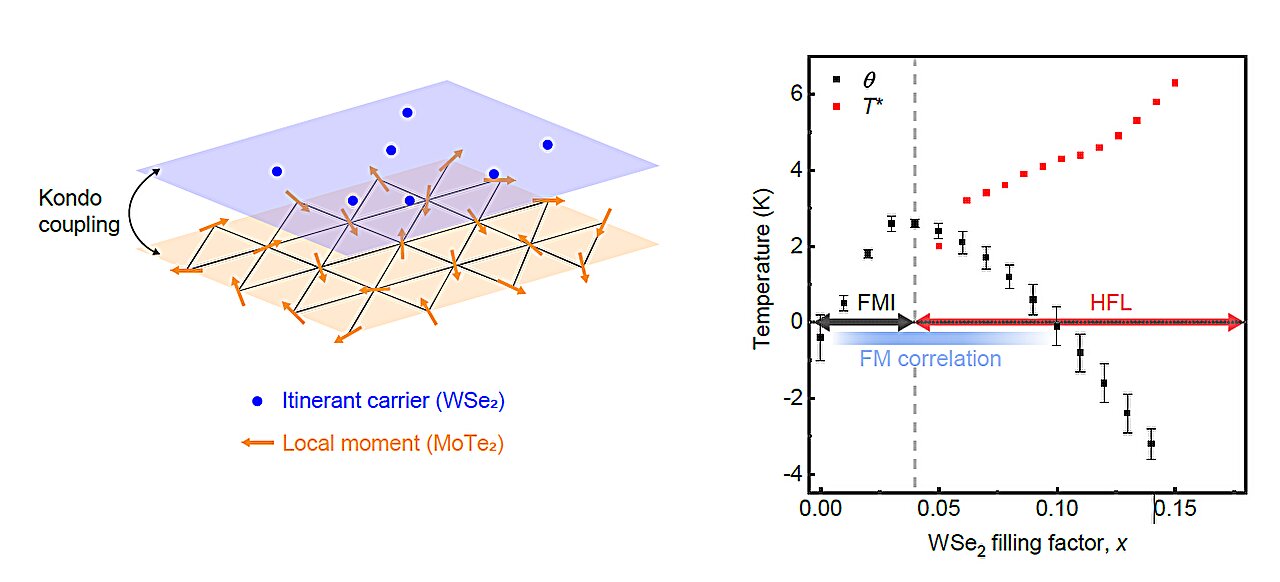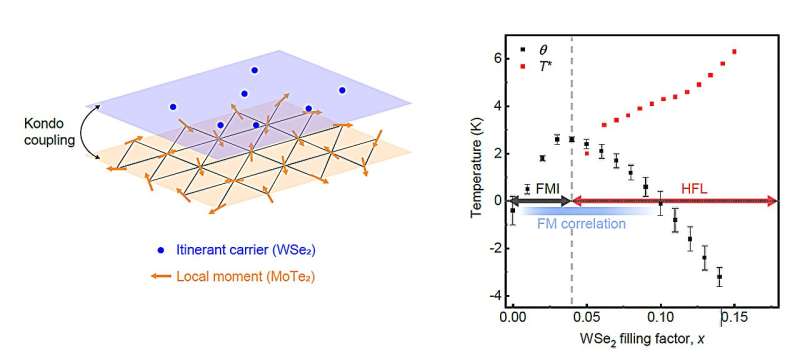

Moiré superlattices are materials consisting of two layers stacked on top of each other with either a small rotational misalignment or a lattice mismatch between them. The Kondo lattice model, on the other hand, describes systems in which conduction electrons interact with localized magnetic impurities, which changes the systems’ electrical and magnetic properties.
In recent years, physicists have successfully engineered materials that combine the physical properties of these two types of systems. These materials, known as moiré Kondo lattices, are essentially moiré superlattice structures with periodic arrangement of localized magnetic moments, resembling that described by the Kondo lattice model.
Researchers at Kavli Institute at Cornell for Nanoscale Science, Cornell University and the National Institute for Materials Science in Japan have been synthesizing and examining moiré Kondo lattices, in the hope of gaining a better understanding of their underlying physics.
Their most recent paper, published in Nature Physics, reports the emergence of ferromagnetism at the onset of a density-tuned Kondo breakdown in MoTe2/WSe2 moiré bilayers.
“Our work builds on our earlier report on the realization of an electrically tunable moiré Kondo lattice system,” Kin Fai Mak, co-author of the paper, told Phys.org. “There we have reported the fabrication of an artificial Kondo lattice using moiré semiconductors and the observation of gate tunable heavy fermions.”
A key objective of research efforts investigating the physics of Kondo lattices is to better understand how heavy fermions in these systems break down under varying external parameters, such as doping density, magnetic field and interaction strength. This breakdown, known as the Kondo destruction transition, is often accompanied by the emergence of exotic states of matter (e.g., the non-Fermi liquid phase and unconventional superconductivity).
In their previous research, Mak and his colleagues engineered a highly tunable moiré Kondo lattice system based on MoTe2/WSe2 moiré bilayers. This material offers a unique opportunity to examine the Kondo destruction transition in a continuous manner, which has proved highly challenging in bulk heavy fermion materials.
“With this background, our Nature Physics paper studied the fate of the heavy fermions by continuously tuning the density of the itinerant carriers in the system, which tunes the effective Kondo coupling strength,” said Mak. “Near a critical density, we observed a destruction of the heavy fermions and the simultaneous emergence of a ferromagnetic Anderson insulator.”
As part of their new study, the researchers examined the Kondo lattice physics emerging in the moiré semiconductor: angle-aligned MoTe2/WSe2 heterobilayer presented in their previous paper. Their results highlight the promise of moiré Kondo lattices for studying the Kondo destruction transition using a tunable platform, as well as the possibility of realizing other exotic states of matter near such transition.
“A moiré lattice emerges in the material because of the 7% lattice mismatch between MoTe2 and WSe2,” explained Mak. “As a result, no twist angle is required to create the moiré superlattice potential. We fabricated dual-gated Hall bar devices; the device allows independent control of the total doping density in the material as well as the relative partition of doping densities in each transition metal dichalcogenide layer.”
Using their fabrication strategy, Mak and his colleagues could prepare their material in the Kondo lattice regime, which allowed them to study the Kondo destruction transition continuously as it occurred. To probe the emergence of magnetic states in the proximity of this phase transition, they used a combination of magneto-transport and magneto-optical spectroscopy.
“We measured the anomalous Hall response and the spontaneous circular dichroism in the material to demonstrate the emergence of a ferromagnetic Anderson insulator,” said Mak. “We also examined the temperature and magnetic field dependent transport properties to show that the ferromagnetic Anderson insulator emerges near the Kondo destruction transition.”
The measurements collected by this research team yielded interesting results. As their material approached the density-tuned Kondo destruction transition, Mak and his colleagues observed a near simultaneous occurrence of a metal-to-insulator and a magnetic quantum phase transition.
“Since the two transitions involve different degrees of freedom (one is charge and the other is spin), the occurrence of the two transitions at nearly the same critical density is unexpected,” said Mak. “The observation invites new ideas on how to describe this transition without invoking fine-tuning of parameters in theory.”
When their material approached the Kondo destruction transition, the team also observed ferromagnetic correlations. This observation is in contrast with most of the previous studies focusing on other known Kondo destruction transitions, which instead reported antiferromagnetic magnetic correlations and ordering.
The recent study by Mak and his colleagues thus opens new interesting opportunities for the study of the Kondo destruction transition. Specifically, it enables the investigation of this transition in a different regime, marked by ferromagnetism instead of antiferromagnetism.
“An immediate plan for further research will be to push the Kondo destruction transition to occur at higher critical densities by engineering the material’s twist angle,” said Mak. “Much less impact from disorders is expected at higher critical densities, thereby allowing us to study the quantum phase transition in a more intrinsic manner.
“Earlier theoretical studies have predicted signatures of quantum spin liquids in the intrinsic regime, where exotic non-Fermi liquids may also emerge.”
In their next studies, the researchers also plan to search for emergent topological states of matter in the Kondo lattice regime. This will be achieved by examining the moiré Kondo lattice they synthesized while further increasing the density of itinerant charge carriers.
“Recent theoretical studies have pointed out that the Kondo interaction in our material system is chiral, thereby opening the door to realize topological Kondo insulators and topological Kondo semimetals,” added Mak. “We are actively searching for transport and thermodynamic signatures of these phases of matter.”
More information:
Wenjin Zhao et al, Emergence of ferromagnetism at the onset of moiré Kondo breakdown, Nature Physics (2024). DOI: 10.1038/s41567-024-02636-4
© 2024 Science X Network
Citation:
Physicists report emergence of ferromagnetism at onset of Kondo breakdown in moiré bilayer lattices (2024, October 17)
retrieved 17 October 2024
from https://phys.org/news/2024-10-physicists-emergence-ferromagnetism-onset-kondo.html
This document is subject to copyright. Apart from any fair dealing for the purpose of private study or research, no
part may be reproduced without the written permission. The content is provided for information purposes only.